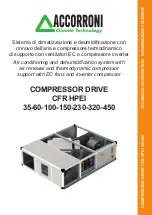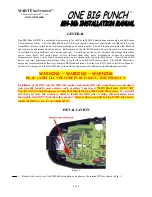
This repair guide applies to the following Omega Compressor Models:
Omega Super Charger and Turbocharger
Warning
Prior to Starting any Repair or Service
Make sure the power cord is disconnected from the compressor
All air is completely released from the compressor
1. Gauge replacement — disconnect the connector on the back of the gauge, unscrew the 3 Philip head
screws, take out old gauge, install new gauge and push connector back on, tighten screws.
2. Water pump replacement — Drain water from unit, disconnect quick connector at the circuit board ,
loosen the two (2) hose clamps. Install new water pump and reconnect the connector at circuit board.
3. Fan replacement — Disconnect quick connector. Unscrew four (4) Philip head screws. Please Note: The
fan placement should be directed so that the air blows into fan. Install new fan and replace all the hardware.
4. Fill hose replacement — Use a 14 mm wrench, unscrew fill hose and install the new hose, tighten the
new fill hose. Use soapy water to test for any air leaks.
5. Air/Water separator replacement and Automatic solenoid — Disconnect the 3 wires on the side of the
solenoid, make note of the color and position of wires. Use (2) 14mm wrenches and undo the steel line from
the bottom and from the top inside of the air/water separator. Remove all the screws that hold the case on.
Carefully remove the case, watch out for wires and hoses that might get caught up. Take out the 2 small
screws on top of separator. Carefully pull out and disconnect solenoid. To take apart solenoid, loosen nut on
top of black coil, unscrew plunger housing from air/water separator, being careful not to lose the small spring
that is inside of plunger, clean plunger and oil it.. Install the new Air/Water separator and put solenoid back
together making sure small spring is inside of plunger. Replace all the lines and wires.
6. Burst Disc replacement — Use a 19 mm wrench to hold the brass fitting tightly while a 14 mm wrench is
used to undo the brass fitting that holds the burst disc in place. Remove the damaged burst disc. Install the
new burst disc and gently tighten the brass fitting. Then spray soapy water around the burst disk and check
for any air leaks.
7. Piston Isolation Tool — The enclosed tool is used to isolate each piston in order to determine whether
the other is malfunctioning. To use, remove the brass 19mm fitting on top of the compressor. Remove the
spring and check valve. Screw in the Piston Isolation Tool until hand tight. Set the gauge to 4000-4500 psi,
install the test plug into the fill hose disconnect and run compressor as normal. If the system does not build
pressure, then the piston opposite the tool is malfunctioning and should repaired. Contact a repair facility for
troubleshooting. If the pressure builds up to the psi setting, the piston opposite the tool is functioning
normally. Bleed the system, re-install the spring and check valve, and tighten the 19mm brassing until
wrench tight. You can then test the opposite piston by doing the same steps to install the Piston Isolation
Tool into the opposite 19mm brass fitting.






























